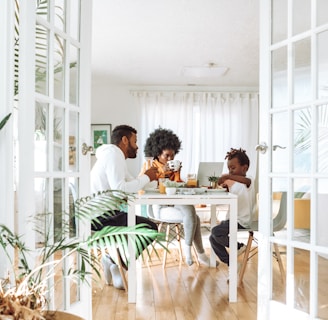A Powerful Parenting Tool for Co-Regulation: Taking the Temperature of the Room
Practical ways to practice "taking the temperature of the room" to support co-regulation with your child at home.
Priscilla Nyo, LMFT IFECMHS
7/30/20253 min read


A Powerful Parenting Tool for Co-Regulation: Taking the Temperature of the Room
Have you ever walked into a room and just felt the tension, even before anyone said a word? Or noticed that your usually cheerful child is suddenly quiet in the corner—and you’re not sure what shifted? This was your internal state naturally taking the temperature of the room without saying a word or “knowing” what was going on.
That’s what we mean by “taking the temperature of the room.” It’s about pausing for a moment to notice what’s happening emotionally and energetically—in your child, in yourself, and in the room around you.
And it’s one of the most powerful tools we have as parents—especially when it comes to co-regulation.
What Does It Mean to “Take the Temperature”?
It’s not about being hypervigilant or overanalyzing every little thing—it’s about tuning in.
Taking the temperature means checking in with:
🧍🏽♀️ Yourself: What’s going on in your body and mind? Are you feeling rushed, overwhelmed, calm, tired, frustrated, content?
🧒🏽 Your child/children (or anyone in the room): What’s their energy like—high, low, scattered, tense, cheerful, chill? Are they regulated or dysregulated?
🫱🏽🫲🏾 The connection between you: Is there connection or disconnection? Are you out of sync or in flow together?
It's a moment of mindful observation—noticing the emotional climate before reacting, redirecting, or correcting.
Why This Helps with Co-Regulation
Young children aren’t born knowing how to calm themselves down or make sense of big feelings. They rely on us—our bodies, our voices, our presence—to help them get back to their "feeling their best" state. They literally "borrow our nervous system", in order to regulate their own. This process is called co-regulation.
But here’s the thing: we can’t co-regulate well if we’re not aware of what’s happening in the moment. That’s where temperature-checking comes in. When we notice the energy rising, or the tone shifting, we can respond in ways that helps us all regulate and feel our best. With practice this will transform your co-regulation together and create building blocks for your child's life long self-regulation skills.
Ways to Practice “Taking the Temperature”:
Like any skill, this takes practice—and it starts with small moments.
Here are a few ways to "take the temperature" in your daily parenting life:
Pause Before You React
Before jumping in to redirect behavior or fix a problem, take one deep breath and ask:
What’s the energy like right now? What’s my child showing me with their body, tone, or pace? What’s happening inside me?Notice Your Own Signals
Do you feel tension in your shoulders? Are you raising your voice without realizing it? Are you rushing, or calm and grounded? What do you need right now?Observe the Room
Is the space chaotic or calm? Is it noisy, overstimulating, or spacious and quiet? Sometimes a child’s dysregulation is a reflection of the environment around them.Name What You Notice (if helpful)
“I think we’re all feeling a little wiggly right now!” or “This room feels really sad. Let’s go outside and get some sunshine.”
The Bonus Benefits of "Taking the Temperature":
✅ Helps you slow down and respond, instead of reacting
✅ Increases connection and attunement
✅ Builds your child’s emotional awareness
✅ Prevents power struggles before they escalate
✅ Models self-awareness and emotional regulation skills for your children
It’s Not About Being Perfect—It’s About Being Present
You won’t always catch the cues 100% of the time. And that’s okay. What matters is your intention to notice, to adjust, and to stay connected—even in the hard moments.
So next time you walk in a room and things feel off… pause, breathe, and take the temperature.
It might just change the direction of your day.
If co-regulating big feelings at home for you and your little one is increasingly challenging, reach out for support from a professional in your area.
Live in California and interested in services for your family?
Click here to learn more about supportive therapy services with Priscilla!
Nyo Therapy: Early Years Child Therapy
Providing child play therapy, parent child therapy, in-home play therapy and parent supports to families in San Diego, CA. Priscilla Nyo (Tebelman), LMFT specializes in infant family and early childhood mental health services. Priscilla offers support in home, in office and via telehealth.
Contact Priscilla
priscilla@nyotherapy.com
619-289-8093
© 2025. All rights reserved.
